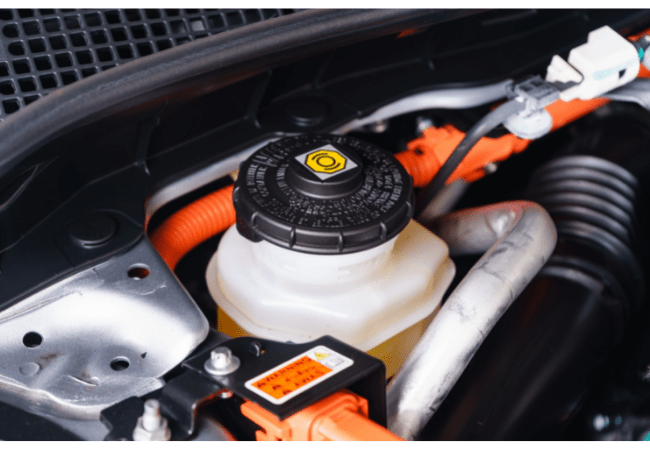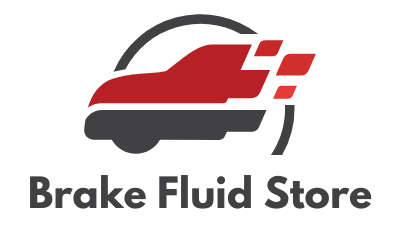Brake fluid works like a lifeblood for your vehicle’s braking system that allows you to stop your vehicle when needed. It transfers the pressure you put on your brake pedal to the brake calipers, and brake pads and makes sure that it stops your vehicle when needed without brake failure. Discover what are the different types of brake fluid and their uses in your vehicle.
It would be nearly impossible to stop your vehicle safely without brake fluid. That’s why it’s critical to use the right type of brake fluid according to your vehicle’s braking system needs.
Contents
What Qualities Should Every Brake Fluid Have?

The brake fluid that you use in your vehicle’s braking system must pass the ability test to remain functional at very high boiling point temperatures. It must also resist boiling and be compatible with other brake fluids of the same chemical composition.
According to the NHTSA (National Highway Traffic Safety Administration), every type of brake fluid must pass testing against the following standards.
- Minimize the corrosion and rust in the vehicle’s brake system.
- Must operate seamlessly with other components of the vehicle’s braking system.
- Should be compatible with other brake fluids of the same category.
- Resist evaporating (or boiling) at high braking system temperatures.
- Remain in the liquid form at extremely low temperatures, which means it must not solidify.
All types of brake fluid must pass these tests and after testing, they’re denoted with the “DOT + Number” form. The DOT stands for (Department of Transportation) and the number refers to the brake fluid’s boiling point. The bigger the number the higher the boiling point.
Different Types of Brake Fluids Explained
As mentioned earlier, there are different types of brake fluids available in the market but most vehicles in the United States use the DOT 3 and DOT 4 brake fluids. Both of these types are hygroscopic, which means they absorb moisture and become less effective over time.
As the brake fluid absorbs more moisture, the brake master cylinder reservoir or the braking system tank tends to become empty. In order to prevent premature degradation of brake fluid, the master cylinder reservoir must not be opened, unless it’s extremely necessary.
Keep in mind that the degradation process naturally occurs through accelerating and braking. It also enhances the buildup of debris and rust in your vehicle’s brake system. That’s why you need to change your brake fluid after some time regardless of its type.
Before getting into the details of different types of brake fluid, it’s important to understand the following terms.
- Dry Boiling Point: The dry boiling point of any brake fluid is the boiling temperature of new or fresh brake fluid, which is stored in an unopened container.
- Wet Boiling Point: The wet boiling point refers to the brake fluid’s boiling temperature once it has been degraded (absorbed 3.7 percent water).
DOT 2
The DOT 2 brake fluid is based on mineral oil and it’s not commonly used in the automobile industry. This brake fluid comes with very low dry and wet boiling points. Interestingly, the dry boiling point of the DOT 2 brake fluid is the wet boiling point of DOT 5.1 and DOT 5 brake fluids.
- Wet boiling point: 284 degrees Fahrenheit or 140 degrees Celsius
- Dry boiling point: 374 degrees Fahrenheit or 190 degrees Celsius
DOT 3
The DOT 3 brake fluid comes in amber color and it’s based on glycol. It’s one of the most commonly used types of brake fluid that also offers a low dry boiling point. However, its wet boiling point is higher than DOT 2. Being a glycol-based brake fluid, it can damage your car’s paint and you need to be extra careful while dealing with this type of brake fluid.
It’s also hygroscopic and absorbs water, which means you need to change this brake fluid every couple of years.
- Wet boiling point: 284 degrees Fahrenheit or 140 degrees Celsius
- Dry boiling point: 401 degrees Fahrenheit or 205 degrees Celsius
DOT 4
DOT 4 is also a common type of brake fluid and is most commonly used in vehicles made by European manufacturers. It’s also based on glycol but offers higher wet and dry boiling points than DOT 3.
That’s because it contains some additives such as borate-ester that allow this brake fluid to reduce the amount of acid produced by moisture absorption. Bear in mind that it costs almost twice as much as the DOT 3 brake fluids.
It’s mostly installed in cars used for domestic purposes and it also comes in some other classifications as well including FOT 4 racing and DOT 4 low viscosity. The most common color of this brake fluid is blue and it can be mixed with DOT 3.
- Wet boiling point: 311 degrees Fahrenheit or 155 degrees Celsius
- Dry boiling point: 446 degrees Fahrenheit or 230 degrees Celsius
DOT 5
DOT 5 is a unique type of brake fluid because unlike other glycol-based fluids, it’s based on silicone. It comes with a distinct purple hue and usually costs twice as much as DOT 4. It comes with very high wet and dry boiling points and also offers a very long shelf life.
One of the best features of DOT 5 brake fluid is that it doesn’t absorb water. However, it has the tendency to produce air bubbles and become foamy that can cause a spongy or soft brake pedal. That’s why it doesn’t work well in some types of brake systems.
Keep in mind that the chemical composition of DOT 5 brake fluid is entirely different from other brake fluids. So, it can’t be mixed with any other type of brake fluid. It also means that you can’t use this brake fluid in your brake system that runs on any other type.
It is most commonly used in high-performance racing cars and can be used for a longer period of time as it doesn’t absorb water.
- Wet boiling point: 356 degrees Fahrenheit or 180 degrees Celsius
- Dry boiling point: 500 degrees Fahrenheit or 260 degrees Celsius
DOT 5.1
Despite the number “5” in its name, the DOT 5.1 is very different from DOT 5 brake fluid. Unlike DOT 5, the DOT 5.1 brake fluid is glycol-based and can be mixed with DOT 3 and DOT 4. It comes with a long color scheme that ranges from almost translucent to amber.
Technically speaking, it’s actually DOT 4 brake fluid but with a little different chemical makeup that allows it to meet the specifications of DOT 5. Keep in mind that it’s probably the most expensive type of brake fluid as it can cost up to 14 times more than DOT 3 brake fluid. So, it’s not advisable to use this brake fluid in cars that are using DOT 3 or DOT 4 brake fluids.
- Wet boiling point: 356 degrees Fahrenheit or 180 degrees Celsius
- Dry boiling point: 518 degrees Fahrenheit or 270 degrees Celsius
So, What Type of Brake Fluid Should You Buy?
It’s critical to handle all types of brake fluids with care, especially the glycol-based ones. They’re highly corrosive and can damage your vehicle’s paint a great deal if spilled. You’ll need to be extra careful while flushing old brake fluid and adding the new one to your vehicle’s brake system.
When it comes to buying brake fluid, you should always follow the recommendations of your vehicle’s manufacturer. Most car owners need to use DOT 3, 4, and 5.1, but you must follow the factory specifications to make sure that your brake system functions smoothly.
Again, glycol-based brake fluids must not be mixed with DOT 5, which is a silicon-based brake fluid. They’ll react badly and can damage your brake system severely. In the worst cases, you might need to get your entire brake system replaced as well.
When to Change Brake Fluid?
Brake fluids become less efficient with time and they can also clog your brake system from the rust buildup. That’s why you should change your brake fluid at designated intervals. As mentioned, always refer to your manufacturer’s manual to find out the right change interval.
It’s also important to buy high-quality brake fluid only from reputable brands. Bad-quality brake fluid can decrease the lifespan of your vehicle’s brake system. According to the general rule of thumb, you should change your brake fluid after every two to five years.
Can You Mix Different Types of Brake Fluids?
You can mix different types of brake fluid that are based on the same chemicals. For example, all the brake fluids including DOT 3, DOT 4, and DOT 5.1, which are based on glycol, can be mixed together.
However, you can’t mix any of these brake fluids with DOT 5 brake fluid that’s based on silicone. Additionally, if you’re not an expert and don’t know how different brake fluids will react upon mixing, you should try mixing them with one another.
Final Thoughts
Changing your brake fluid after every two to five years will keep your brake system in good condition. However, this interval can vary from vehicle to vehicle and you should always follow your manufacturer’s recommendations.
We hope this guide will help you understand the different types of brake fluids available in the market along with their different properties to make the most informed decision while buying brake fluid for your car.
